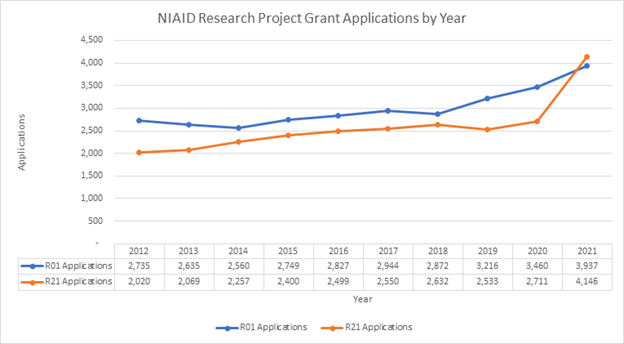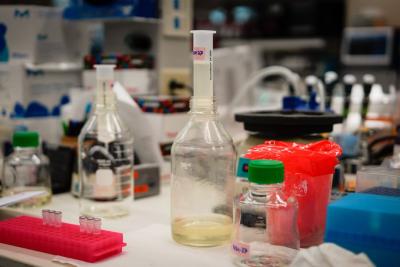It’s strange to think of an NIH grant activity code as being en vogue, but over the past decade the number of exploratory/developmental grant (R21) applications NIAID receives has continually increased, nearly keeping pace with submissions of competing R01 applications.

Data from NIH Report Table #206 Research Project Grants (RPGs). Includes applications for emergency coronavirus-related initiatives.
There are good and bad reasons to choose the R21 activity code for your next investigator-initiated research project grant application. We’ll review them here.
Administrative Basics
The R21 activity code provides up to two years of funding support. Typically, direct costs for the entire project period are capped at $275,000, with no more than $200,000 requested for any one year of the project period. Applicants must use the G.320 - PHS 398 Modular Budget Form.
NIH’s Standard Due Dates for investigator-initiated R21 applications are February 16, June 16, and October 16; although AIDS and AIDS-related R21 applications are instead due on May 7, September 7, and January 7.
There are two parent funding opportunity announcements (FOAs) for R21 grants: NIH Exploratory/Developmental Research Grant Program (Parent R21, Clinical Trial Not Allowed) and NIH Exploratory/Developmental Research Grant Program (Parent R21, Clinical Trial Required). NIAID accepts only low-risk clinical trials through the R21 activity code, and we strongly encourage investigators considering an investigator-initiated clinical trial (IICT) to Follow the NIAID IICT Process to verify a planned study is not high-risk at least 10 weeks before applying.
Not all NIH institutes and centers participate in the R21 parent FOAs, which could limit the awarding components available for you to request on the G.600 - PHS Assignment Request Form but would not constrain your study section assignment preferences.
The parent R21 FOAs do not allow renewal applications.
NIAID does not accept administrative supplement requests for R21 grants, unless specifically called for by a notice of special interest or targeted initiative.
Grantees do not need NIAID’s prior approval for no-cost extensions and carryover on most R21 grants.
Programmatic Niche
The R21 activity code’s administrative aspects complement its programmatic purpose: To support innovative exploratory/developmental research by providing support for the early and conceptual stages of project development. The R21’s short duration and limited scope is ideal for investigators to introduce novel scientific ideas, model systems, tools, agents, targets, and technologies that have the potential to substantially advance biomedical research.
Unlike the R01 parent FOAs, which require you to provide preliminary data in your application, the R21 FOAs allow but do not require preliminary data. This difference underscores the R21’s prioritization of new scientific approaches.
A small project of similar scope to an R21 but using widely accepted approaches and methods is better suited for the small grant (R03) activity code. Examples of projects too narrow for an R21 application but ideal for an R03 grant include secondary analysis of existing data, descriptive studies, and surveys.
Strategic Considerations
Of course, the goal of an applicant is to score well in peer review and receive funding.
Whether because its budget is smaller, it doesn’t require preliminary data, or it doesn’t negate early-stage investigator status, there is a tendency among newly independent researchers to assume the R21 grant is easier to get than an R01 grant and thus an ideal career building block. But those suppositions are false.
The R21 is not designed to be a stepping stone for research career development—it’s meant to be a stepping stone for projects that diverge from an investigator's main thrust of research or support high-risk, high-reward pilot studies.
NIAID offers a preferential payline for new and early-stage investigators applying for an R01 grant, not an R21 grant. The R01 offers five years of funding and can be renewed following a productive project period, which sets a foundation that the R21 cannot match.
Nor are success rates for R21 grants meaningfully better than success rates for R01 grants. Taking fiscal year 2019 as an example, NIAID’s success rate for R21 applications was 21.0 percent. NIAID’s success rate for new R01 applications was 18.8 percent and our success rate for renewal R01 applications was 43.3 percent; taken together, grantees’ ability to renew an R01 grant elevated the success rate for competing R01 applications to 23.0 percent.
NIAID awards hundreds of R21 grants every year. The activity code is ideal for an investigator (or multiple principal investigators) exploring a concept or niche tangential to an ongoing research project.
Shoehorning a project into an R21 application when its Research Strategy and Specific Aims truly necessitate a longer project period or a larger budget will not improve your odds of funding. You should always apply using the activity code that, if funded, gives your research project its highest likelihood of success.


